1. Ancient Beginnings
- Tattoos have been present in India for thousands of years, though the exact origins remain unclear.
- Across various regions, from the jungles of the northeast to the deserts of Kutch, tattoos have served different purposes beyond mere decoration.
2. Tattoos as Jewellery and Identity
- Tribal communities often viewed tattoos as permanent jewelry, something that couldn’t be taken away even if they lost all material possessions.

3. Protection and Cultural Practices
- In the Apatani tribe of Arunachal Pradesh, girls were tattooed to appear less attractive to rival tribes, reducing the risk of abduction.
- The tattooing process involved using thorns to cut the skin and soot mixed with animal fat for color. The government banned this in the 1970s, but some remote areas still practice it.
4. Gender-Specific Tattoos
5. Warrior Tattoos
- The Konyaks of Nagaland, known for their headhunting tradition, tattooed their faces as a sign of bravery and success in battle.
- Tattoos in these tribes also helped establish identity and enabled recognition after death.
6. Southern India’s Tattoo Traditions
- In Tamil Nadu, tattoos were known as "pachakutharathu" and were common until the 1980s.
- Nomadic tattoo artists, known as Korathi, traveled the countryside, inking designs like the kollam, which was believed to protect against evil.
7. Toda Tribe’s Geometric Tattoos
- The Toda tribe in South India tattooed their hands, calves, and shins with geometric patterns similar to their embroidery designs.
8. Central India’s Tattoo Practices
- The Dhanuks in Bihar believed tattoos made women less attractive, helping them avoid unwanted attention.
- The Munda tribe of Jharkhand used tattoos to commemorate victories over the Mughals, with men tattooing three vertical lines on their foreheads.
9. Tattoos as Cultural Symbols
- The Gonds of Central India used tattoos to cover much of their exposed skin, ensuring they appeared decent.

10. Santhal Tribe’s Life Stage Tattoos
11. Western India’s Tattooing Tradition
- The Rabari women of Kutch practiced tattooing for decorative, religious, and therapeutic purposes using simple tools like a single needle and gourd bowl for pigment.
12. Tattoos in Marital and Social Practices
- Tattoos among the Kothari and Rajput women served as symbols of blessings and aristocracy, with designs such as Krishna’s crown signifying high status.
13. Revival and Modern Tattoos
- In recent decades, tattoos have become a fashion statement among urban Indian youth, with designs ranging from tribal patterns to modern art.
- Artists like Manjeet Singh, Abhinandan Basu, and Mo Naga have gained international recognition, with their work blending traditional motifs with contemporary styles.
Tattoos have been an integral part of India’s cultural and social fabric for centuries, evolving from symbols of identity and protection to modern expressions of fashion and personal belief.